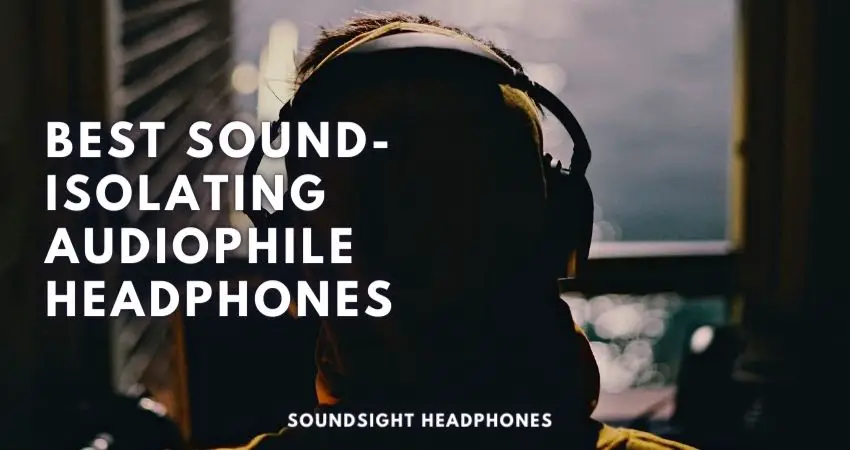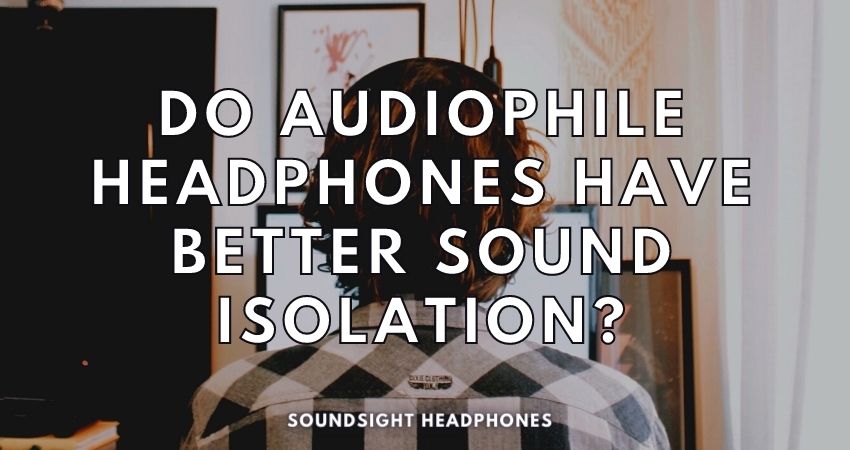In your search for audiophile headphones, you’ve probably wondered whether audiophile headphones offer better sound isolation than regular headphones. People who want to get the most out of their music or watch movies on their headphones can’t afford to have background noise interfere with their listening experience. Therefore, good passive sound isolation is necessary.
In this article, I’ll answer your question about audiophile headphones and how well they isolate external noises and explain what factors ensure good passive noise insulation.
Audiophile headphones vs. regular headphones – Which isolates noise better?
Audiophile headphones do not necessarily isolate noise better than regular headphones. But it also depends on the type of headphones you’re comparing.
Regular headphones come in many types: gaming headphones, wireless, ANC, and sports headphones. The same goes for audiophile headphones, some of which are closed or open-ear headphones and in-ear headphones.
The best sound-isolating headphones are mainly ANC headphones and in-ear headphones. Whether they are regular or high-fidelity headphones, these headphones tend to perform the best, so if you are looking for headphones that reduce ambient noise, these are the types of headphones you should focus on.
In-ear and ANC headphones don’t offer the best sound quality. Still, if you want a direct comparison between the best-performing over-ear headphones, some factors come into play regarding sound isolation.
Factors that ensure good sound isolation in audiophile headphones
Multiple variables can affect the sound insulation of headphones; the most important variables are:
- Higher density materials
- Ear cups and cushioning thickness
- Good ear cup sealing
Higher density materials isolate sound the best
Most headphone ear cups are made from PVC plastic, with a specific density and thickness. Compared to luxury materials like the wood used in high-end audiophile headphones, plastic has a higher density, which means it significantly affects sound isolation.
Audiophile headphones with wood ear cups have lower sound isolation. Fostex TH900, for example, has ear cups made of Japanese Cherry Birch, which has a density of around 0.51 – 0.77 grams per cm3 and a thin layer of silver foil. Metal layers and grilles can reduce air vibrations caused by sound waves and improve sound isolation because of their high density.
PVC density:

Density of various wood species:

Metal density:

Takeaway: PVC plastic, a common material used in headphones, has a higher density than most luxurious materials used in audiophile headphones. Because PVC has a higher density, regular headphones should provide better sound isolation than audiophile headphones. However, the material’s thickness is another factor that determines how soundproof your headphones are.
How does density affect sound insulation in headphones
High-density materials reduce the amount of incoming noise by reflecting sound waves, which means the sound waves will not pass through the material. For example, when a sound wave hits a thick glass window, a part of it is reflected off the surface, and a smaller part passes through the glass (which is then lost as heat energy).
Ear cups and cushioning thickness
The ear cups are the most important factor in sound isolation, as they block sound from a wide range of directions. As such, the thickness of the plastic or wood from which the ear cups are made impacts their ability to isolate sound.
Similarly, the thickness of the ear cushions has a significant effect on sound isolation and the frequencies blocked. Thicker, denser pads provide better sound isolation and are more successful at reducing high wavelengths.
Low frequencies or slow soundwaves pass more easily through the ear cups. High frequencies are easier to isolate because they are absorbed by dense, porous memory foam. Low-frequency noise is harder to block, which is why active noise-canceling headphones are so popular.
Low-frequency noises are an issue in both mainstream headphones and audiophile headphones, so it’s not worth wasting time discussing that.
Ear cups that seal your ears well
Lastly, if the ear cups don’t seal well, sound can leak in and out even if your headphones provide utmost sound isolation. No matter how good your headphone’s insulating materials are, if ear cups don’t cover your ears well, the sound insulation is significantly reduced.
The seal depends on three things: the shape of the ear cups, the size of the ear cups, and the tightness of the headphones. Be sure to choose a headset with right-angled ear cups that are firm and won’t sag against your ears. Round ear cups, like the Beyerdynamic DT 770 Pro, can also do the trick, but they may leave some areas uncovered.
Big ear pads can also leave some spots uncovered if they are too large, despite the shape that helps seal your ears well. A mix between the two is ideal: medium-size ear cups but right-angled.
The third factor is the clamping force. Here, it’s important to strike a balance between comfort and tightness: you don’t want your ear cups to be too loose, but you also don’t want the clamping force to be too strong.
The design of the headband, the frame, and the size of your head will influence the clamping force. Too much clamping force can be uncomfortable for some people, and too little clamping force may not provide a good fit either.
In the case of high-fidelity in-ear headphones, the depth of insertion, the seal around the ear canal, and the ear tips’ material are all important to ensure a good fit. These are the main factors that Etymotic in-ear headphones master, making them the number one choice for sound isolation.

Best sound-isolating audiophile headphones
If you often find yourself in loud environments or with noisy surroundings, these audiophile headphones may make it easier for you to tune out the chaos:
- Etymotic ER4SR
- Sennheiser IE 60
- Audeze EL-8 Closed back
- Focal Celestee
- Audio-Technica ATH-M50X
- KZ AS10
Some of the best-isolated audiophile headphones are commonly in-ear headphones because they fit deep into the ear canal, which is the only way for noise to reach your eardrum. As such, the Etymotic ER4SR, Sennheiser IE60, and KZ AS10 are all high-fidelity in-ear headphones that offer fantastic passive noise isolation. The sound quality of KZ is a bit lower, but they are great noise-isolating headphones nonetheless.
Closed-back headphones offer less sound isolation than in-ear headphones, but they are much more comfortable and sound better. The Audeze EL-8 closed headphones offer excellent passive noise isolation and a balanced listening experience for those looking for a fantastic high-fidelity closed-back headphone with good passive noise reduction.
These are just recommendations, so check out this article on the best noise-isolating audiophile headphones if you want to know more.
FAQ
Do audiophile headphones need good sound isolation?
Audiophile headphones are specially designed to improve music playback and provide an immersive listening experience; however, sound isolation is not always the most noticeable feature of these headphones.
Audiophiles do care about sound isolation, especially when listening to closed-back headphones, and knowing whether audiophile headphones have better sound isolation than regular headphones is important to them.
Conclusion
Some audiophile headphones’ sound isolation measurements are hard to find on the Internet and in the information provided by reviewers. It’s difficult to compare the sound isolation level of one set of headphones to another without testing. But the tips given in this article are a good starting point for determining whether your headphones offer good passive noise reduction.
